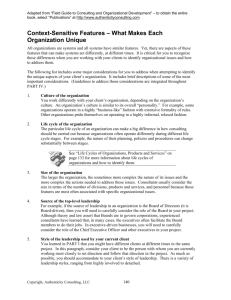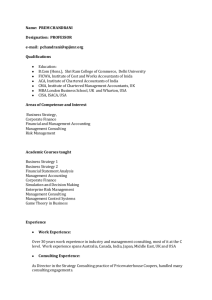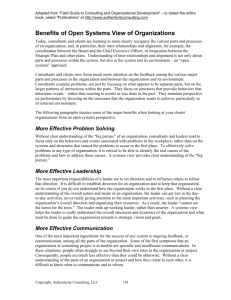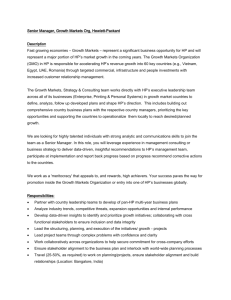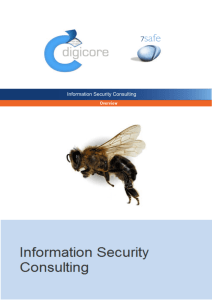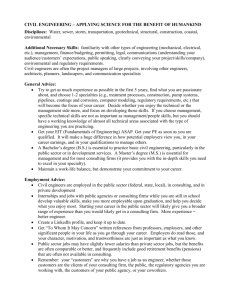Running Head: FROM CONCEPT TO APPLICATION: AN
advertisement
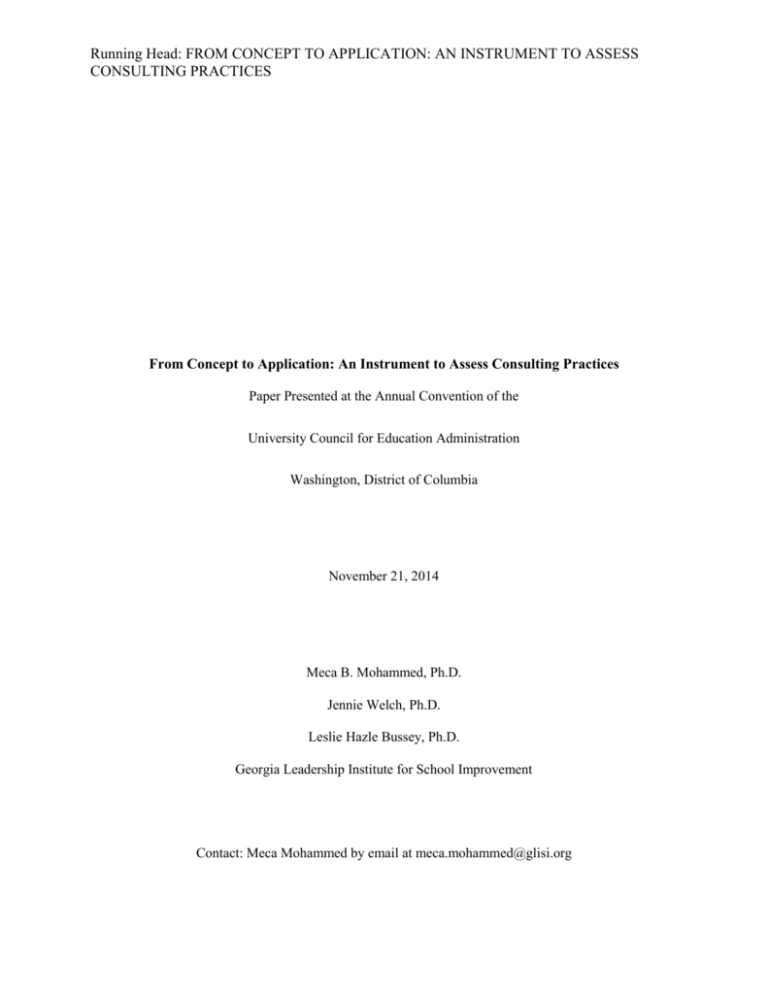
Running Head: FROM CONCEPT TO APPLICATION: AN INSTRUMENT TO ASSESS CONSULTING PRACTICES From Concept to Application: An Instrument to Assess Consulting Practices Paper Presented at the Annual Convention of the University Council for Education Administration Washington, District of Columbia November 21, 2014 Meca B. Mohammed, Ph.D. Jennie Welch, Ph.D. Leslie Hazle Bussey, Ph.D. Georgia Leadership Institute for School Improvement Contact: Meca Mohammed by email at meca.mohammed@glisi.org Running Head: FROM CONCEPT TO APPLICATION: AN INSTRUMENT TO ASSESS CONSULTING PRACTICES Statement of Purpose Consulting organizations can be catalytic partners to school districts seeking to drive systemic improvement. Federal initiatives such as the School Leadership Program and Race to the Top, as well as state and local policy directives, have encouraged and incentivized the role of consulting organizations in school improvement. Assumed benefits of district-consultant partnerships range from an increase in district capacity resulting from the support provided by the consultant to student achievement gains to the promise of financial/efficiency gains for one or both partners. However, the involvement of a consulting organization does not guarantee these outcomes or other indicators of success. As these partnerships continue to proliferate in our nation's schools (Ashraf & Uddin, 2013; Fincham, 2006; Hassel & Steiner, 2004), there is a growing need to understand the factors that are most likely to yield successful partnership outcomes. This paper builds upon our previous research (Bussey, Welch, & Mohammed, 2014; Mohammed, Welch, & Bussey, forthcoming) and seeks to understand the aforementioned factors by (1) developing operational definitions of the quality domains of effective consulting organizations and (2) developing an instrument that measures these concepts in real-world application. Developing measurable and observable indicators that codify the practices of effective consulting along with an instrument that can measure the effectiveness of these practices advances our understanding of what constitutes a successful consulting partnership within the context of education. Armed with such knowledge, school district leaders and policy makers can make more informed decisions about selecting particular consulting organization partners, while consulting organizations can use such information to guide continuous improvement efforts. Background In 2012, our research team noticed that a growing number of organizations, including universities, nonprofit organization, for-profit organizations, consulting firms, and independent consultants were emerging as partners to school systems pursuing systemic improvement efforts. We also noticed that the outcomes achieved were as varied as the types of partnerships emerging in the education landscape. The proliferation of partnerships, coupled with the disparate results 1 Running Head: FROM CONCEPT TO APPLICATION: AN INSTRUMENT TO ASSESS CONSULTING PRACTICES achieved through the partnerships, caused us to question what role, if any, the interaction of school systems and their partners played in the success of systemic improvement efforts. In response, we employed a cross-disciplinary review of literature to explore the processes and strategies used by consulting organizations as partners to school systems. The findings of the literature review were used to develop a conceptual framework which identified essential quality domains of three agents: consultants, districts, and the partnership itself (see Appendix A). This framework served as the foundation for further exploration of the emergent quality domains. In the second year of our research, we narrowed our focus to the consulting agent— while still recognizing that the other agents play a pivotal and significant role in systemic school and district improvement (Mohammed et al., forthcoming). Given the critical role consultant partners often play in supporting system reform efforts, we were curious to understand the characteristics district leaders look for in a consultant when seeking a partnership. Are they aligned with the qualities of effective consulting agents that we had previously identified? Are particular qualities perceived as more important than others? To explore this line of inquiry, we employed an exploratory sequential mixed methods approach (1) to assess whether the quality domains of consultants most prevalent in the literature and privileged in our framework were consistent with multiple sources of expert knowledge in the field; and (2) to determine which, if any, quality domains of consultants were perceived as more important than others for partnership success. Our findings showed strong alignment between the quality domains identified in the literature and expert knowledge on how those domains are experienced at the point of practice. While no specific domain or set of domains emerged as most dominant, interpersonal skills and content expertise were identified as foundational indicators that crosscut the other domains. Furthermore, two additional quality domains that did not emerge in the review of literature were identified by district leaders as being important at the organizational level for the consulting agent: diverse experiences and value alignment (see Appendix B). We have presented these findings at various education conferences, shared our results with district leaders, utilized the findings to examine our own consulting practice, and invited critical peer-review of our research through the publication process. The motivation for this paper stems from three questions that were consistently raised by practitioners and scholars when they reviewed our findings across these venues: 2 Running Head: FROM CONCEPT TO APPLICATION: AN INSTRUMENT TO ASSESS CONSULTING PRACTICES 1. How can these results be used to inform organizational decisions that directly affect the quality of district-consultant partnerships? 2. How can these results be used to drive organizational improvements within consulting organizations and school districts? 3. How can these results be used to inform the behavior of individual consultants, school and district leaders, and the processes employed by both agents in partnership with one another? Responding to any of these questions requires a transformation of our conceptual framework into observable indicators for measurement in practice. This is the first purpose we seek to achieve in this paper, and, similar to the approach we took in the second year of our research, we remain focused on the consulting agent in pursuit of this purpose. Responding to these questions also requires that these indicators be organized in a way that makes them useful for one or more of the agents identified in our framework. The following section describes the methodology we employed in order to develop measurable, observable indicators of the qualities of effective consulting agents. It also describes the methodology we employed to develop an instrument designed to (1) inform organizational decisions; (2) drive organizational improvements; and (3) inform the behavior of individual consultants, district leaders, and partnership processes. Methods The overarching purpose of this research endeavor was to develop an instrument that could be used to assess consulting effectiveness at the organizational level. We employed data collection and analysis activities that are consistent with well-known approaches to instrument development (Clement, Chauvot, Philipp, & Ambrose, 2003; Moore & Benbast, 1991; Roblyer & Wiencke, 2003; Schmiedel, Brocke, & Recker, 2014), wherein an initial set of conceptual definitions derived from theory development guides the research process. Our process consisted of three phases: (1) item generation, (2) scale development, and (3) content expert validation. Because a primary aim of this study was to use the resulting instrument to assess our own work as a consulting partner to school systems, it was critical to involve “those who need to act on its 3 Running Head: FROM CONCEPT TO APPLICATION: AN INSTRUMENT TO ASSESS CONSULTING PRACTICES results to bring about change” or improvements within the organization (Salsberg, Seller, Shea, & Macaulay, 2012, p. 183). We selected Participatory Action Research (PAR) as most appropriate for engaging all staff employed by our consulting practice in the research process referenced above, as well as two individuals who currently serve on our organization’s Board of Directors. The Board members serve a key internal stakeholder role as part of our organization’s governing body, while also possessing deep knowledge in the management consulting industry. 1 The PAR approach reflects the basic tenets of action research, which encourages self-reflection among those participating in the research to promote more effective work practices (Sagor, 2000). This is accomplished through a recursive process of planning, reflection, and action. What distinguishes PAR from other types of action research is that participants collaborate with researchers to “carry out a process of fact finding, conceptualization, planning, implementation and evaluation to simultaneously solve problems and generate new knowledge” (Khan & Chovanec, 2010). To promote this level of collaboration within our study, researchers served as participants on the PAR team, working alongside other staff to transform the quality domains of the consulting agent into observable indicators for measurement in practice. Results This section describes the results of our work to date. The discussion is organized around the phases of our research process, beginning with item generation, followed by scale development and content expert validation. Phase 1: Item Creation The intention of the first PAR session was to clarify the consulting domains that emerged through our previous research and to generate a list of candidate behaviors or “look-fors” within the domains (see Appendix C for an agenda). The objectives we identified for the first PAR session were as follows: 1 Board members are affiliated with Bain Consulting and North Highland Consulting, a management consulting firm based in Atlanta, Georgia. 4 Running Head: FROM CONCEPT TO APPLICATION: AN INSTRUMENT TO ASSESS CONSULTING PRACTICES (1) Provide PAR team with a brief overview of our previous research findings; (2) Ensure shared understanding about the goals of the PAR team; (3) Review the “look-fors” in consulting practice brainstormed by PAR participants; (4) Engage in thoughtful discussion about the “look-fors” and refinement of the “lookfors,” culminating in a list of measurable and observable indicators of effective consulting practice aligned with the eight quality domains identified in prior phases of our research. The first PAR session achieved the first two objectives. The team was provided with an overview of our previous research findings yielding productive discussion that challenged the PAR team goals as they had been conceptualized. Two primary challenges to the goals were proposed: 1) our focus on the consulting agent and their practice was less likely to yield productive outcomes than a focus on the district agent portion of our framework; and 2) development of an instrument that focused on organizational level indicators of consulting effectiveness would be less productive than an instrument designed to evaluate individual consultants. These two challenges diverted discussion away from reviewing and refining “look-fors” into measurable and observable indicators of consulting practice. Instead, PAR session facilitators asked probing questions to gain better clarity around the concerns raised and to determine if the rest of the team shared these concerns. Ultimately, the team agreed on the value of continuing to focus on the consulting agent, and more specifically, agreed that a goal of the PAR team should be to establish measurable and observable indicators of consulting effectiveness aligned to the framework domains. Team members referenced the dearth of empirical literature that focuses on the consultant partner relative to the expansive body of empirical literature focused on the district partner as a validation of this goal. Team members also referenced the internal needs of our consulting organization as a reason to sustain focus on the consulting agent, stating that the absence of measurable and observable indicators of our own organizational effectiveness had real implications for how we evaluate the success of our partnerships with districts. 5 Running Head: FROM CONCEPT TO APPLICATION: AN INSTRUMENT TO ASSESS CONSULTING PRACTICES With respect to the second concern about the unit of analysis, team members agreed that what would be of most value to the organization would be an instrument that could be used in the selection of highly effective individual consultants, as opposed to an instrument designed to evaluate organizational consulting effectiveness. Team members cited the organizational need to recruit, select, develop, and retain a cadre of highly effective consultants during the current fiscal year as a pressing reason for shifting focus, arguing that a resource that could guide these efforts would be of more value in the short term than a tool designed to evaluate consulting effectiveness in the long term. Team members also agreed that a shift in focus did not mean any of the high level objectives initially established would be compromised—an instrument focused on assessing the qualities of individual consultants would still (1) inform organizational decisions; (2) drive organizational improvements; and would have the potential to (3) inform the behavior of individual consultants, district leaders, and partnership processes. Phase 2: Scale Development Guided by these refined goals following the PAR session, researchers took the lead in conducting an initial review of “look-fors” that were submitted by other PAR team members. Given the change of focus from a tool used to assess organizational effectiveness to a tool that could be used to hire highly effective individual consultants, researchers determined that it was critical that we engage our organization’s director of consulting services in a final review of the “look-fors.” We submitted the “look-fors” to an independent scale developer who had been identified through a rigorous RFP process and selected for her expertise in psychometrics and assessment. Feedback from the scale developer indicated that the submission provided insufficient detail to develop consulting behaviors into a scale that demonstrated measurable, observable behaviors, rather than trait descriptions. As a result, the scale developer modified the behaviors, enhancing the detail provided under each consulting domain to advance the scale from listing traits towards clear behaviors that could be assessed across performance levels. The initial scale was developed following two additional exchanges between PAR team members and the scale developer. Supporting documentation included as Appendix D outlines the scoring process. The first column, Consulting Behavior, has the ideal or highest level of the behavior. If a consultant 6 Running Head: FROM CONCEPT TO APPLICATION: AN INSTRUMENT TO ASSESS CONSULTING PRACTICES exhibits that behavior, he or she would receive a point for that behavior. The scale, as it was submitted, classified expertise into four categories: (1) Ineffective, (2) Somewhat Effective, (3) Effective, and (4) Highly Effective. Under this scoring scheme, GLISI could document with (supporting notes) experience documented in the resume, as well as behaviors that could be observed during interviews and consultant trainings. Supporting notes under rating 1, 2, 3, or 4 would identify the level of expertise exhibited. Informed by over 15 years of consulting experience and a review of our previous research, our organization’s director of consulting services perceived the quality domains to fall into three tiers. As a result, scores would be weighted by tier and aggregated to generate an overall score. For example, a behavior such as “Dedicating time to understanding client needs and prior experiences,” which is associated with interpersonal skills, would be a more valuable asset for consultants representing our organization to exhibit than “Creating detailed project plans with realistic timelines,” which falls under the project management domain. Tier 1 scores were multiplied by 3 for total of 33 points; Tier 2 scores were multiplied by 1 for a total of 17; Tier 3 scores were multiplied by 0.5 for total of 5 points. The maximum score for the submitted scale was 50 points (see Appendix D). Table 1 shows a breakdown of the originally proposed tier structure: Table 1: Originally Proposed Tier Structure 2 Tier 1 2 3 Quality Domains Interpersonal skills Content expertise Process expertise Agility Role expectations Project management Diverse experiences 2 Based on the intended use of the instrument, the director of our organization’s consulting services determined that value alignment was an organizational level domain and not as important to evaluate in individual consultant behavior. Therefore, it was not included in the originally proposed tier structure. 7 Running Head: FROM CONCEPT TO APPLICATION: AN INSTRUMENT TO ASSESS CONSULTING PRACTICES Phase 3: Content Expert Validation The primary objective of the second PAR session was to gauge content validity of the items through rigorous review by our team (see Appendix E for an agenda). The objectives we identified for the second PAR session were as follows: (1) Ensure behaviors aligned to the definition of the domain; (2) Verify whether the behaviors were measurable and observable; (3) Identify additional behaviors for inclusion in the scale; (4) Determine which stage of the process each behavior is most likely to be observed: initial screening, training session, or field observation. The second PAR session achieved the first three objectives. The team engaged in structured activities designed to elicit clear and specific feedback on the accuracy of the behaviors, as well as their association with the domains. Participants were in relatively strong agreement regarding the degree to which the behaviors operationalized and accurately reflected the domains. Suggested changes included adjusting descriptions associated with behaviors to increase precision of the measures. Several participants indicated that the behaviors were too broad and, if included as written, would introduce high levels of subjectivity into the scoring the process, comprising the reliability of the instrument. Participants also identified several instances where behaviors were not fully representative of the domains with which they were associated, and offered recommendations for where the behaviors should be reassigned. These adjustments resulted in the elimination of “diverse experiences” given the items originally associated with this domain were either omitted or reassigned to “content expertise.” Though not directly related to session objectives, one participant challenged the three tier structure used to weight domains based on perceived importance to consulting effectiveness described above, noting that our prior research—which found that interpersonal skills and content expertise are foundational elements that crosscut the other domains—would suggest a structure of no more than two tiers. The team agreed, and responded by reorganizing the domains into two tiers, with interpersonal skills and content expertise occupying Tier 1. By default, the remaining four domains: process expertise, agility, role expectations and project management 8 Running Head: FROM CONCEPT TO APPLICATION: AN INSTRUMENT TO ASSESS CONSULTING PRACTICES were classified as Tier 2. Appendix F reflects this new tier structure, as well as the final list of behaviors associated with each of the six domains. While the final objective of the second PAR session was not achieved in collaboration with the full team, a member of the research team worked separately with the director of our organization’s consulting services to identify the stage(s) of the hiring process each behavior is most likely to be observed: initial screening, training session, or field observation. As shown in Appendix F, it was determined that behaviors may be observed during one or multiple stages of the process. The scale developer is currently in the process of using this document to finalize the instrument. Once developed, this tool will be leveraged to more accurately assess the behaviors and characteristics associated with effective consultant practices. Conclusion This paper documents the progress and potholes encountered by a research team that set out to enhance the practical utility of findings from our previous studies of effective consulting partners. Our (we felt) thoughtfully conceptualized research questions and methods met with the uncooperative “real world,” requiring that we make refinements to our research goals and intended outcomes along the way. While this was challenging to embrace, it is consistent with the responsive and fluid nature of the research approach we selected: Participatory Action Research. Despite navigating these unexpected turns in our research journey, the resulting product remains rather true to the initial purposes we set out to meet. That is, we have developed a tool that can be used by multiple agents to increase the quality and productivity of partnerships forged between school districts and consulting organizations (or individuals) for purposes of school and system improvement. Specifically, the tool in its early iteration, surfaces explicit and observable consultant practices associated with effectiveness. As such, the tool can be used by district or school leaders to assess prospective consulting partners prior to contracting with them, as well as to evaluate their performance during and at the end of contracted engagements. Consulting organizations can use the indicators and instrument to assess individual consultants. Coupled with district needs assessments, they can then better align individual consultants or consultant teams with individual district leaders or district teams. 9 Running Head: FROM CONCEPT TO APPLICATION: AN INSTRUMENT TO ASSESS CONSULTING PRACTICES Outside the context of a district-consulting organization partnership, organizations that earnestly pursue continuous improvement may choose to use the tool or indicators independent of a consulting engagement to drive organizational improvement. For example, the indicators developed through this study could be used by consulting organizations to assess their bench of consultants as a whole or individual consultants on the team for purposes of making staffing changes or offering professional development opportunities as needed. Indeed, the instrumentation can be especially helpful in the recruitment and selection of consultants by helping organizations – such as universities as they recruit adjuncts or identify faculty for consulting engagements – to be explicit and clear about qualities they seek, and to use those clear criteria to guide hiring and selection protocols. The criteria could also assist in providing evaluative feedback to consultants throughout the conduct of a consulting engagement. As the number of consultants and consulting organizations in the education landscape continues to multiply, the need for a clear set of quality criteria and methods for evaluating their effectiveness is increasingly urgent. There is reason to believe that some consultants and third party organizations have successfully added value and built capacity in their partner school districts (Levin, Datnow & Carrier, 2012). However, for the millions of dollars spent on education consultants (by some estimates, up to 25% of SIG expenditures were for consultants equating to approximately $1.25 billion (Brown, 2012)), relying only on chance that “some” consultants will be effective is inadequate. Our intention was to turn a critical lens on our own consulting practice; deprivatize excellence in practice so that all agents in the calculus of selecting consulting organizations can be empowered in making decisions about allocating resources most effectively; and advance the conversation in the field toward a uniform set of criteria and ways of discussing measurement of consulting effectiveness. We believe we have achieved our purposes and invite others to join us in making education consulting practice transparent so that we may improve our efforts – or cease if needed– in ultimate service of the students that we serve through our district partners. 10 Running Head: FROM CONCEPT TO APPLICATION: AN INSTRUMENT TO ASSESS CONSULTING PRACTICES References Ashraf, M.J., & Uddin, S. (2013). A consulting giant; A disgruntled client: A ‘failed’ attempt to change management controls in a public sector organization. Financial Accountability & Management, 29(2), 186-205. Brown, J. (2012, February 19). Cost doesn’t spell success for Colorado schools using consultants to improve achievement. The Denver Post. Retrieved from http://www.denverpost.com/ Bussey, L. B., Welch, J. C., & Mohammed, M. B. (2014). Effective consultants: A conceptual framework for helping school systems achieve systemic reform. School Leadership & Management, 34(2), 156-178. Clement, L., Chauvot, J., Philipp, R., & Ambrose, R. (2003). A method for developing rubrics for research purposes. In N. A. Pateman, B. J. Dougherty, & J. T. Zilliox (Eds.), Proceedings of the 2003 joint meeting of PME and PMENA (Vol. 2, pp. 221–227). Honolulu: CRDG, College of Education, University of Hawaii. Fincham, R. (2006). Knowledge work as occupational strategy: Comparing IT and management consulting. New Technology, Work, and Employment, 21(1), 16-28. Hassel, B., & Steiner, L. (2004). Guide to working with external partners. Naperville, IL: Learning Point Associates. Khan, C. & Chovanec, D. M. (2010). Is participatory action research relevant in the Canadian workplace? Journal of Contemporary Issues in Education, 5(1), 34-44. Levin, B., Datnow, A., & Carrier, N. (2012). Changing school district practices. Retrieved from http://www.studentsatthecenter.org/sites/scl.dl-dev.com/files/Changing%20School %20District%20Practices.pdf. Mohammed, M. B, Welch, J. C., & Bussey, L. H. (Forthcoming). Bridging theory and practice: A Conceptual framework for consulting organizations. School Leadership & Management. Moore, C. G., & Benbasat, I. (1991). Development of an instrument to measure the perceptions of adopting an information technology innovation. Information Systems Research, 2(3), 192-222. Roblyer, M. D., & Wiencke, W. R. (2003). Design and use of a rubric to assess and encourage interactive qualities in distance courses. The American Journal of Distance Education, 17(2), 77-98. Sagor, R. (2000). Guiding School Improvement with Action Research. Alexandria, Virginia: Association for Supervision and Curriculum Development. 11 Running Head: FROM CONCEPT TO APPLICATION: AN INSTRUMENT TO ASSESS CONSULTING PRACTICES Schmiedel, T., Brocke J., & Recker, J. (2014). Development and validation of an instrument to measure organizational cultures’ support of business process management. Information Management, 51, 43-56. 12 Running Head: FROM CONCEPT TO APPLICATION: AN INSTRUMENT TO ASSESS CONSULTING PRACTICES APPENDIX A: Framework of District-Consultant Partnerships Consulting Organization Quality Domains: Partnership Quality Domains: Content Expertise Process Expertise Interpersonal Skills Agility Role Expectations Project Management Locus of Accountability Trusting Relationships Focus on Building School System Capacity School System Quality Domains: Leadership Capacity Trusting Relationships Structural Alignment Role Expectations Project Management School System’s Capacity to Achieve Systemic Improvement Goals This framework suggests: • • • • The quality domains of the consulting organization will have a direct effect on the school system’s quality domains. The quality domains of the partnership will have a direct effect on the school system’s capacity to achieve systemic improvement goals. The quality domains of the school system will have a direct effect on the school system’s capacity to achieve systemic improvement goals. The quality domains of the consultant and the school system have reciprocal effects on the quality domains of the partnership. 13 Running Head: FROM CONCEPT TO APPLICATION: AN INSTRUMENT TO ASSESS CONSULTING PRACTICES APPENDIX B: Revised Framework of District-Consultant Partnerships Consulting Organization Quality Domains: Partnership Quality Domains: Content Expertise Process Expertise Interpersonal Skills Agility Role Expectations Project Management Locus of Accountability Trusting Relationships Focus on Building School System Capacity School System Quality Domains: Leadership Capacity Trusting Relationships Structural Alignment Role Expectations Project Management Value Alignment Diverse Experiences School System’s Capacity to Achieve Systemic Improvement Goals This framework suggests: • • • • The quality domains of the consulting organization will have a direct effect on the school system’s quality domains. The quality domains of the partnership will have a direct effect on the school system’s capacity to achieve systemic improvement goals. The quality domains of the school system will have a direct effect on the school system’s capacity to achieve systemic improvement goals. The quality domains of the consultant and the school system have reciprocal effects on the quality domains of the partnership. 14 Running Head: FROM CONCEPT TO APPLICATION: AN INSTRUMENT TO ASSESS CONSULTING PRACTICES APPENDIX C: PAR I Agenda Consulting Effectiveness: Participatory Action Research, Session #1 9/04/14 Welcome Introductions of Board and Staff History of Consulting Effectiveness Research Purpose and Importance of Year 3 Work Board Member Perspectives Indicators of Consulting Effectiveness Small Group Break Out Identifying Consulting Effectiveness “Look Fors” Break Group Discussion “Honing in” on Measurable/Observable “Look Fors” Wrap-Up 15 Running Head: FROM CONCEPT TO APPLICATION: AN INSTRUMENT TO ASSESS CONSULTING PRACTICES APPENDIX D: GLISI Consulting Effectiveness Scale Score by Tier Content Expertise Tier 1 Consulting Behaviors Multiply x3 11 behaviors (Max 33 points) 1 Ineffective Fails to exhibit most of the Tier 1 behaviors, with few, if any concrete examples. For present behaviors, exhibits them with inconsistency. May exhibit some Tier 2 and Tier 3 behaviors. 2 Somewhat Effective Exhibits only some of the Tier 1 behaviors, providing some or weak examples. Does not show evidence of doing so consistently. Also exhibits some of the Tier 2 and Tier 3 behaviors. 3 Effective 0-19 points 20-29 points 30-39 points 40-50 points Total Score_______ Total Score_______ Total Score______ Total Score_______ Exhibits most of the following behaviors in Tier 1, however may not provide concrete examples for all of the behaviors across domains, and may apply them with less consistency. Also demonstrates many or most Tier 2 and Tier 3 behaviors. 4 Highly Effective Exhibits all or most of the following behaviors in Tier 1 AND does so consistently, providing specific examples as evidence. Also shows mastery of most of the Tier 2 and 3 behaviors. Explicitly communicates an understanding of the continuous school improvement process. Experience developing strategic improvement plans at the organizational level Integrates knowledge regarding the 16 Running Head: FROM CONCEPT TO APPLICATION: AN INSTRUMENT TO ASSESS CONSULTING PRACTICES Interpersonal Skills impact of current legislation and mandates into content delivery, strategic planning, and/or coaching activities Identifies and highlights key/relevant trends in leadership that are pertinent to the consulting engagement Uses a deliberate line of questioning to help client better understand behavior or challenges Dedicates time to understanding client needs and prior experiences Fosters/develops healthy relationship with client by monitoring client trust/engagement Speaks directly to client about needs and perceptions of the state of the engagement Communicates complex ideas in language that makes sense to client Speaks with tact and sensitivity when discussing difficult topics References relevant prior experience in order to build rapport with clients 17 Running Head: FROM CONCEPT TO APPLICATION: AN INSTRUMENT TO ASSESS CONSULTING PRACTICES Agility Process Expertise Tier 2 Multiply x1 17 behaviors (Max 17 points) Asks tailored questions to gain additional information Probes client for more information when there is ambiguity Integrates/connect s data from multiple sources to make a cohesive plan Uses specific information (i.e. school data, conversations, etc.) to craft solutions Actively seeks feedback and critique from key actors on the project Writes reports that communicate progress, midcourse corrections, and outcomes Exercises discretion when communicating difficult topics Communicates in a manner that focuses on the problem rather than the person Behaves with flexibility to meet client needs Makes in-themoment adjustments to questioning approach using feedback/reaction from the client Adjusts plans to accommodate the 18 Running Head: FROM CONCEPT TO APPLICATION: AN INSTRUMENT TO ASSESS CONSULTING PRACTICES need for midcourse correction Demonstrates leadership when ambiguity arises (i.e. asks appropriate questions, make suggestions about possible solutions, etc.) Role Expectations Dialogues with client about needs rather than giving directives Solicits ongoing feedback from client to co-create solutions Outlines all key players in the consulting engagement Develops plans with roles outlined Communicates expectations of all players in the engagement Inspires each partner to complete the engagement successfully Project Management Tier 3 Multiply x0.5x 10 behaviors (Max 5 points) Creates detailed project plans with realistic timelines Proactively discusses timeline with client Identifies timeline concerns and presents alternatives/soluti ons when absolutely needed Uses appropriate tools such as 19 Running Head: FROM CONCEPT TO APPLICATION: AN INSTRUMENT TO ASSESS CONSULTING PRACTICES Diverse Experiences Blackboard, Google Docs, dashboard, eBoard, PowerPoint, Microsoft Office Suite to complete engagement Collects ongoing data to monitor progress towards goals Experience coaching teacher leaders, school leaders and district leaders in a variety of contexts Experience facilitating professional learning for teacher leaders, school leaders, and district leaders Effectively draws upon diverse experiences to build leader capacity within the client Cites outside evidence to establish credibility (literature, data, etc.) Connects relevant prior experience to client’s course of action and outcome in order to establish credibility with clients 20 Running Head: FROM CONCEPT TO APPLICATION: AN INSTRUMENT TO ASSESS CONSULTING PRACTICES APPENDIX E: PAR II Agenda Consulting Effectiveness: Participatory Action Research, Session #2 10/10/14 Meeting Overview Meeting Purpose Desired Outcomes Consultant Management Overview Components of the Process Timeline Use of the Consultant Management Tool Consultant Management Tool Overview Original PAR Purpose and Evolution Initial Scale Development Consultant Management Domains Activity #1: Domains and Behaviors Activity #2: Observable Behaviors Activity #3: Missing Behaviors Activity #4: Connecting Behaviors to the Process Wrap-Up 21 Running Head: FROM CONCEPT TO APPLICATION: AN INSTRUMENT TO ASSESS CONSULTING PRACTICES APPENDIX F: Consulting Management Domains, Behaviors and Observation Stages Domain Broad Description Behaviors TIER I Content Expertise Interpersonal Skills Screening Knowledge, experience, and credibility in the field of education, directly related to GLISI’s mission and strategic framework Dispositions related to a consultant’s effective interactions with GLISI team members and district clients through relationship building, effective communication, initiative, and commitment to partnership goals Experience facilitating professional learning for teacher leaders, school leaders, and/or district leaders Experience developing strategic improvement plans at the organizational level Experience coaching teacher leaders, school leaders, and/or district leaders in a variety of contexts Explicitly communicates an understanding of the continuous school improvement process Integrates knowledge regarding the impact of current educational policy into consulting engagement Insights specific to different educational contexts: rural, suburban, urban, grade level Effectively draws upon experiences with change leadership and organizational change to build leader capacity within the client Identifies and highlights key/relevant trends in leadership that are pertinent to the consulting engagement Incorporates knowledge of principles of adult learning and development Connects examples of effective practice, outside evidence, and/or experience to client’s course of action and outcome in order to establish credibility with clients Training Observation X X X X X X X X X X X X X X X X X X X X X X X Dedicates time to understanding client needs and prior experiences Speaks directly to client about needs and perceptions of the state of the engagement Communicates complex ideas in language that makes sense to client Communicates with tact and sensitivity when discussing difficult topics X X X X X X Respects and honors confidentiality (GLISI and client organization) Communicates in a manner that focuses on the problem rather than the person X X X X Surfaces and resolves conflict proactively TIER II Process Expertise Knowledge, experience, and skills in consulting processes, including effective collaborations with all relevant stakeholders, datadriven interactions, and the ability to achieve Employs a deliberate line of questioning to help client better understand behavior or challenges Utilizes data from multiple sources to identify root causes and craft solutions Actively seeks feedback and critique from key stakeholders on the consulting engagement Differentiates approach to consulting engagement based on client X X X X X X X 22 Running Head: FROM CONCEPT TO APPLICATION: AN INSTRUMENT TO ASSESS CONSULTING PRACTICES Domain Broad Description the outcome for which the consultant was hired Agility Role Expectations Ability to make corrections and adjustments in order to offer solutions that are responsive to district client’s needs while maintaining focus on partnership goals Ability to comprehend purpose and goals of partnership and to achieve clarity around expectations for all stakeholders engaged in the partnership Behaviors Communicates with GLISI when challenges arise in the consulting engagement Includes all key stakeholders in processes and communication X Behaves with flexibility to meet client needs consistent with the scope of work X Uses feedback/reaction from the client to make appropriate adjustments to questioning approach X Adjusts plans and approaches to accommodate the need for mid-course correction X Project Management X X Asks appropriate questions when ambiguity arises Makes suggestions about possible solutions when ambiguity arises X X Accesses additional resources and experiences when needed X X Dialogues with client about options rather than giving directives Solicits ongoing feedback from client to co-create solutions Outlines roles and responsibilities for all key stakeholders in the consulting engagement Respects GLISI guidelines regarding copyright usage and intellectual property Behaves as an ambassador for GLISI, promoting the organization’s values and partnership goals X X Reinforces/conveys authority and expertise Skills required to ensure consulting engagements are implemented effectively through the use of protocols, process, and procedures to meet project specifications X X X X X X X X X X X Uses GLISI resources, templates, and processes to manage the consulting engagement X Creates detailed project plans with realistic timelines X X Proactively monitors timeline with client Maintains regular and clear communication with assigned GLISI team member X Identifies timeline concerns and presents alternatives/solutions when needed X Uses appropriate tools such as Blackboard, Google Docs, dashboard, eBoard, PowerPoint, Microsoft Office Suite to support communication and shared expectations Writes reports that communicate progress, midcourse corrections, and outcomes according to schedule Uses ongoing data to monitor progress towards goals X X X X 23
